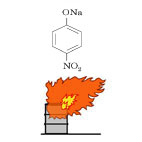| Case Name |
Fire caused by explosion of p-nitrophenol sodium salt due to friction during transfer with a conveyor |
| Pictograph |

|
| Date |
August 25, 1979 |
| Place |
Fukuyama, Hiroshima, Japan |
| Location |
Chemical factory |
| Overview |
On August 25th, 1979, dried p-nitrophenol sodium salt ignited during transfer into a warehouse in Fukuyama, Hiroshima. The warehouse exploded and was totally destroyed by fire. The cause was considered to be overheating due to friction around the conveyor. |
| Incident |
Raw material for pesticide production ignited during being transferred into a warehouse due to friction, and the warehouse exploded and burned completely. |
| Processing |
Manufacture |
| Individual Process |
Transfer |
| Process Flow |
Fig2.Unit process flow
|
| Substance |
p-nitrophenol sodium salt, Fig3 |
| Type of Accident |
Explosion, fire |
| Sequence |
Dried p-nitrophenol sodium salt was transferred into a warehouse by a screw conveyor. White fumes were seen around the conveyor, and the warehouse exploded and burned completely. |
| Cause |
Dried p-nitrophenol sodium salt was ignited by friction during transfer with a screw conveyor. |
| Knowledge Comment |
1. Friction control of a screw conveyor.
2. Is it appropriate to use a conveyor for transferring combustible materials? Use of pneumatic conveying with inert nitrogen gas might be an appropriate choice for transferring powder and pellets. |
| Background |
The operation was routine work and it is not clear why friction was generated. Inadequate maintenance of a conveyor such as over-tightening or dropping foreign materials into a key place of the conveyor was suspected. |
| Reason for Adding to DB |
Example of explosion and fire caused due to frictional heat during transfer with a conveyor |
| Scenario |
| Primary Scenario
|
Carelessness, Insufficient Precaution, Carelessness to Handling of Impact Danger Material, Poor Value Perception, Poor Safety Awareness, Insufficient Recognition of Risk, Usage, Maintenance/Repair, Friction Generated at Conveyor, Bad Event, Mechanical Event, Friction, Secondary Damage, External Damage, Explosion, Loss to Organization, Economic Loss, Failure of Buildings
|
|
| Sources |
Masamitsu Tamura. Masahide Wakakura. Explosion of p-nitrophenol sodium salt. Reaction danger - Accident case and analysis - p. 89(1995)
|
| Physical Damage |
40 square meters of the factory burned, 61 square meters ware house completely burned |
| Multimedia Files |
Fig3.Chemical formula
|
| Field |
Chemicals and Plants
|
| Author |
YOSHINAGA, Jun (Graduate School of New Frontier Sciences, The University of Tokyo)
TAMURA, Masamitsu (Center for Risk Management and Safety Sciences, Yokohama National University)
|